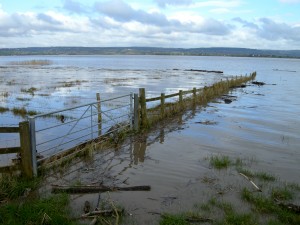Somerset Flooding needs "future solutions" - WWT's CEO

While the wet weather means great conditions for high numbers of water birds at WWT Wetland Centres, our thoughts are with people whose lives and businesses are blighted by flooding.
Wetlands play a crucial part in protecting people from flooding.
Here's WWT's Chief Executive Martin Spray CBE:
I have utmost sympathy and respect for those affected by flooding in the Somerset Levels and elsewhere.
Since the Prime Minister announced dredging will commence to ease the immediate problem, I’m heartened to hear agreement breaking out that dredging should only be the start of a holistic approach to solving flood management in Somerset.
WWT is already helping with future solutions. We’re managing one of the largest ever created coastal wetlands on the Steart Peninsula where the River Parrett meets the Severn Estuary. Reconnecting areas like this to tides or to rivers in a managed way provides places for large volumes of water where we want it – not where we don’t – and creates fantastic places for wildlife. Replicated along our estuaries and watercourses, this could positively reduce the local flooding risk and provide extensive new grazing land.
WWT’s Consulting arm is already using wetlands to protect homes and businesses from flooding around the world. For example we’re advising the Sri Lankan government on improving, rather than destroying, a wetland in central Colombo. This will absorb high waters, filter out pollution and create a haven for wildlife that can enjoyed by local communities and become a tourist attraction.
While the current focus is on dredging silt from the channels in the Levels, WWT is already working across the UK and the world to stop channels silting up in the first place, by using wetland technology. Wetland Treatment Systems are designed habitats that use wetland plants, such as reeds, to not only slow down water draining off fields, but also filter out silt. Even better, micro-organisms in the wetland break down pollutants and pathogens.
WWT is building small-scale Wetland Treatment Systems across the UK and abroad. Farms, breweries and even an equine hospital are using this technology to treat waste water and control run-off from their own land to reduce silt and pollutants filling up our water channels.
We’re also building Sustainable Drainage Systems nationwide. WWT is working with the Environment Agency and Thames Water on mini-wetlands at 10 schools in North London which sustainably mop up and clean run-off on their own land, which reduces pollution and slows down drainage into the nearby flood-prone Pymmes Brook. The wetlands also help with pupils’ lessons about nature.
Government figures from 2011 estimated wetlands provide the UK with more than £4bn worth of flood defence service per year, simply by being there to store rainwater and release it slowly. This is a huge saving for the taxpayer, which could be even greater if we fully realise the potential of wetlands for both wildlife and people.
This is all for the future. We’re very grateful to landowners in the Somerset Levels who have worked alongside RSPB, the Pensthorpe Conservation Trust and ourselves to create habitat for reintroduced Eurasian cranes – raised at WWT Slimbridge Wetland Centre - to gain a foothold and live alongside them. Their efforts underline that the people who live and work in the Somerset Levels know their area better than anyone else and, right now, getting their lives back on track is the number one priority.

